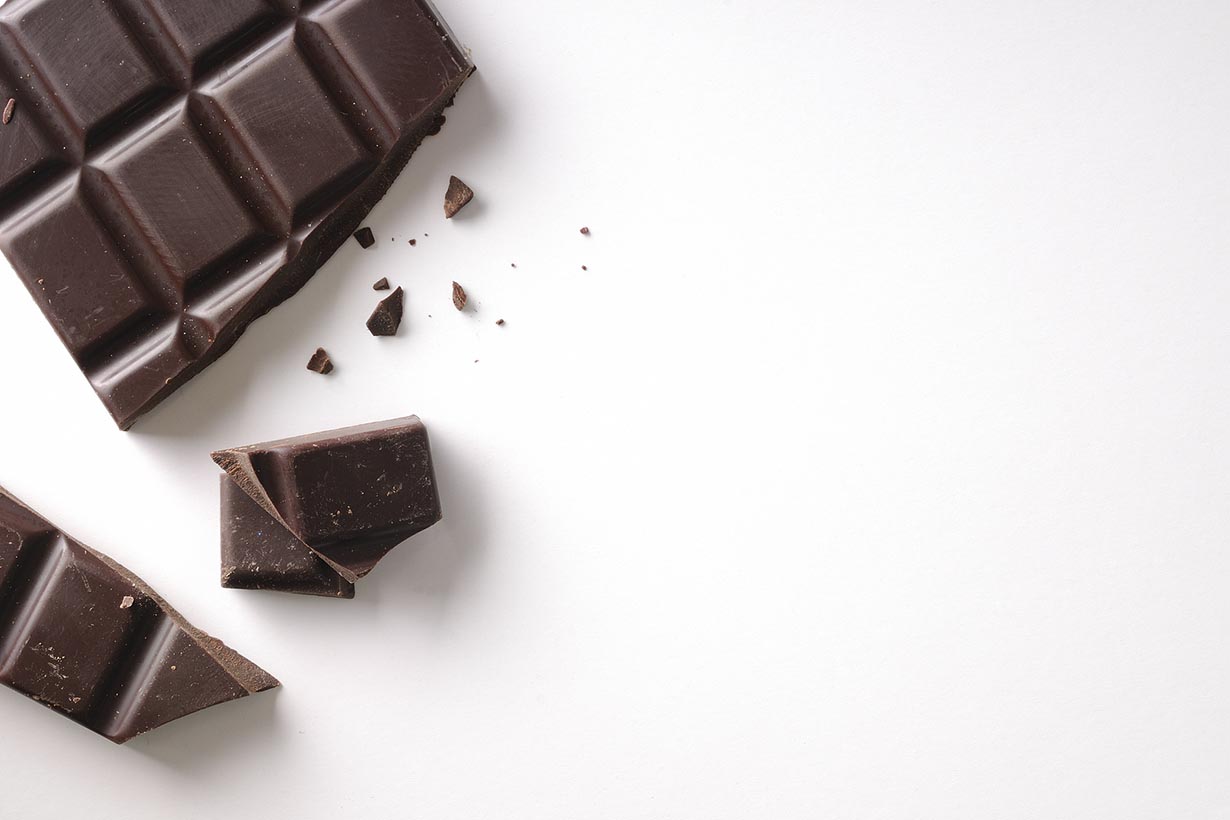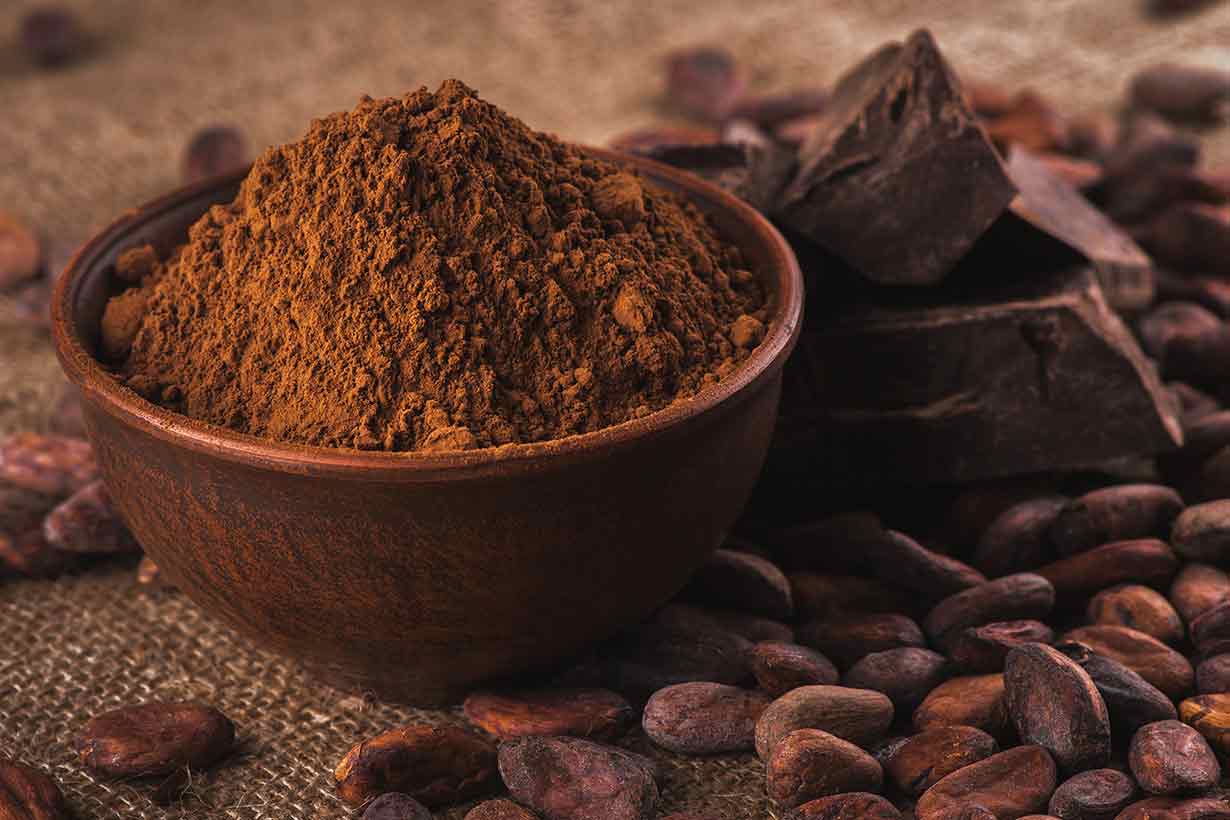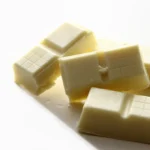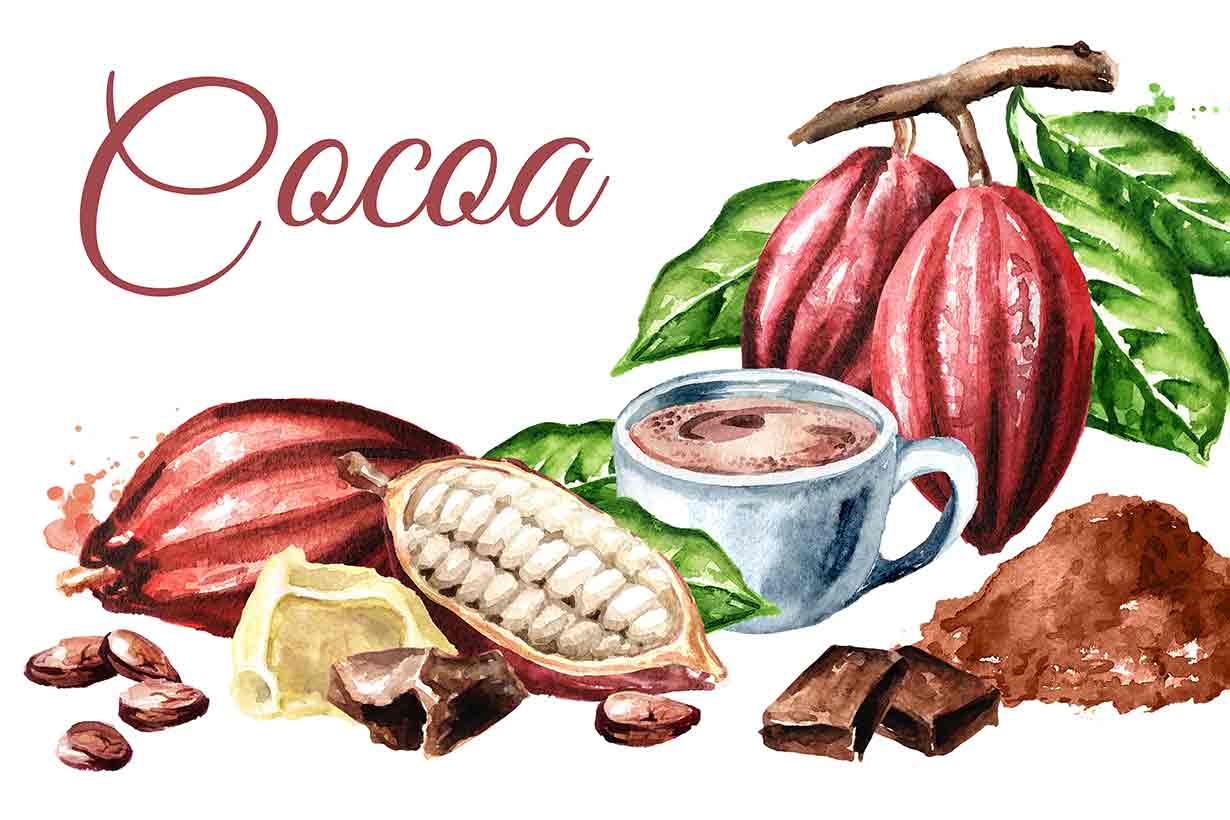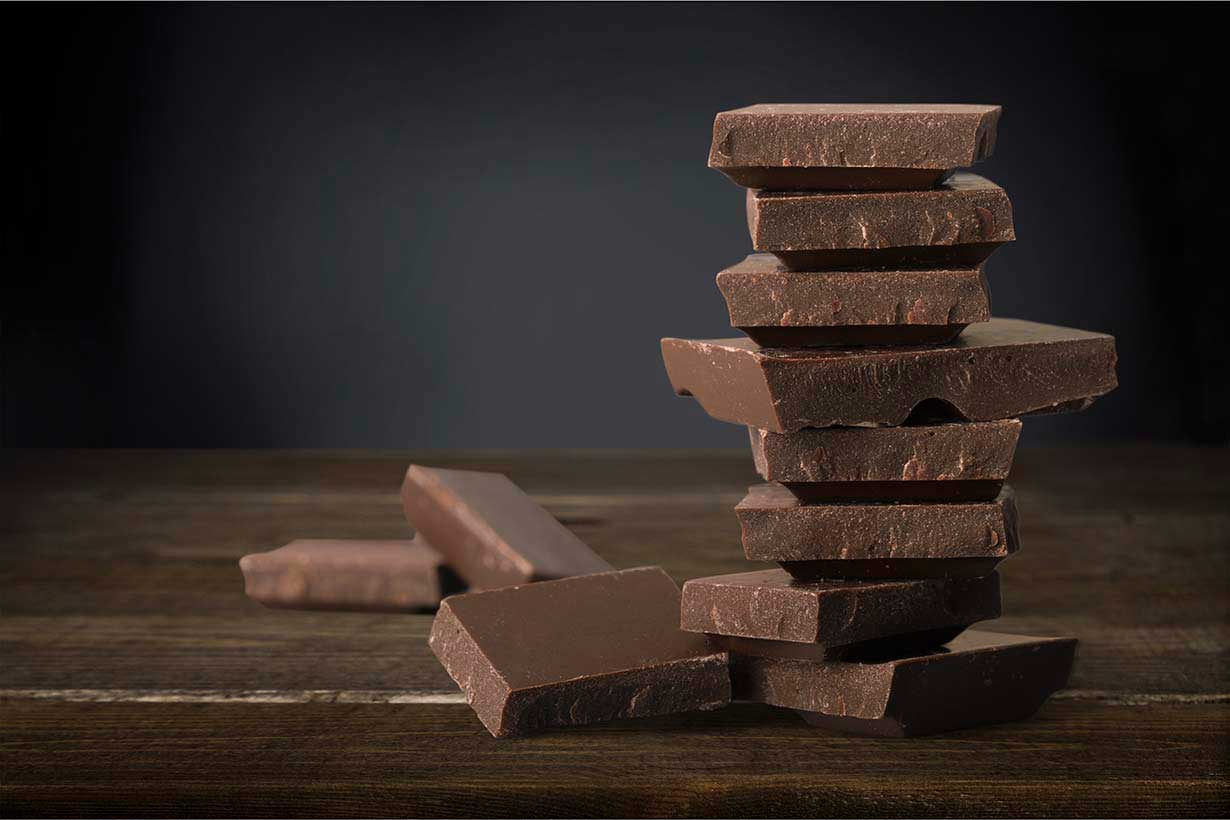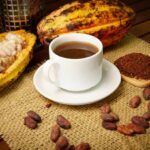Cocoa butter is a pure source of fat extracted from cocoa beans. It is the primary fat in dark chocolate and other chocolate products that give them their smooth and creamy taste.
While it may be popular for its taste properties, is it a healthy choice of fat?
This article takes a look at the nutritional profile, potential benefits, and drawbacks of cocoa butter.
Important Note: The content in this article is for informational and educational purposes only. It should not replace medical advice from your healthcare provider.
Table of contents
What Is Cocoa Butter?
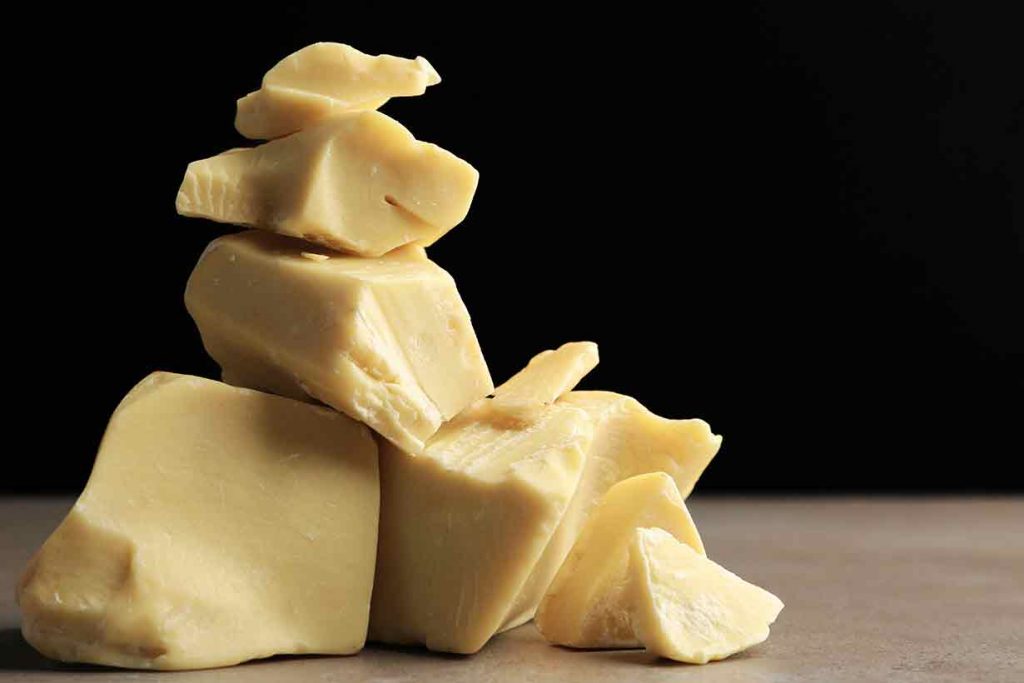
Otherwise known as theobroma oil, cocoa butter is the edible fat that we can find in cocoa beans and most chocolate products.
Despite the word “butter” being in the name, cocoa butter has nothing to do with the dairy ingredient. It is a single ingredient food product solely extracted from cocoa beans.
We can find cocoa butter in chocolate bars, truffles, recipes, and even personal skincare products.
The smooth texture of white chocolate also comes from its cocoa butter content, which is the only part of the cocoa bean found in white chocolate.
Since cocoa butter tends to be quite expensive, it is usually found in higher quality products, particularly if it is the only source of fat in a chocolate product.
For example, more budget-friendly chocolate products (such as those from Hershey and Cadbury) typically use vegetable fats like palm or shea fat as cheaper alternatives.
Nutrition Facts
Let’s now explore the nutritional profile of cocoa butter. The following tables show the complete nutritional values for cocoa butter per 100 grams, based on data from the USDA FoodData Central database (1).
Calories and Macronutrients
| Nutrient | Per 100 g (% DV) | Per 13.6g tablespoon (% DV) |
|---|---|---|
| Calories | 884 kcal | 120 kcal |
| Carbohydrate | 0 g (0%) | 0 g (0%) |
| Fiber | 0 g (0%) | 0 g (0%) |
| Sugars | 0 g | 0 g |
| Fat | 100 g (128%) | 13.6 g (17%) |
| Saturated fat | 59.7 g (299%) | 8.12 g (41%) |
| Monounsaturated fat | 32.9 g | 4.47 g |
| Polyunsaturated fat | 3.0 g | 0.41 g |
| Omega-3 | 0.1 g | 0.01 g |
| Omega-6 | 2.8 g | 0.38 g |
| Cholesterol | 0 mg (0%) | 0 mg (0%) |
| Protein | 0 g (0%) | 0 g (0%) |
As shown above, cocoa butter provides a combination of mainly saturated and monounsaturated fats. As a pure source of fat, it contains no carbohydrates or protein.
Vitamins
| Vitamin | Per 100 g (% DV) | Per 13.6 g tablespoon (% DV) |
|---|---|---|
| Vitamin A (RAE) | 0 mcg | 0 mcg |
| Vitamin C | 0 mg | 0 mg |
| Vitamin D | 0 mcg | 0 mcg |
| Vitamin E | 1.8 mg (12%) | 0.25 mg (2%) |
| Vitamin K | 24.7 mcg (21%) | 3.36 mcg (3%) |
| Thiamin (B1) | 0 mg | 0 mg |
| Riboflavin (B2) | 0 mg | 0 mg |
| Niacin (B3) | 0 mg | 0 mg |
| Pantothenic acid (B5) | 0 mg | 0 mg |
| Vitamin B6 | 0 mg | 0 mg |
| Folate (B9) | 0 mcg | 0 mcg |
| Vitamin B12 | 0 mcg | 0 mcg |
| Choline | 0.3 mg (<1%) | 0.04 mg (<1%) |
Isolated fats don’t tend to be rich sources of vitamins, and this is the case for cocoa butter too.
The only vitamins that it contains are vitamins E and K in small to moderate amounts.
Minerals
Cocoa butter is not a source of essential minerals.
Other Compounds
Unlike other cocoa products, cocoa butter contains virtually no stimulants like caffeine and theobromine.
Although there are small trace amounts present, the concentration is less than 0.1% of the amount in cocoa powder (2).
Is the Fat in Cocoa Butter Healthy?
The table below shows the four major fatty acids in cocoa butter and in what concentrations they are present (1):
| Fatty Acid | Type | Amount (%) |
|---|---|---|
| Stearic Acid | Saturated | 33.2% |
| Oleic Acid | Monounsaturated | 32.6% |
| Palmitic Acid | Saturated | 25.4% |
| Linoleic Acid | Polyunsaturated | 2.8% |
Between them, these four fatty acids make up more than 97% of the total composition.
Only trace amounts of other fatty acids make up the remaining 3%.
Stearic Acid
- Stearic acid is found in cocoa butter and shea butter (3).
- A scientific opinion piece published by the European Food Safety Authority notes that stearic acid has a different effect on blood cholesterol compared to other saturated fats (4).
- A 2020 systematic review also notes that stearic acid can lower LDL cholesterol compared to palmitic acid, another saturated fat (5).
Oleic Acid
- Oleic acid is the most widely distributed fatty acid in nature, and it is the predominant fat in olive oil (6).
- Oleic acid is generally thought to have a neutral to beneficial impact on health. Systematic reviews support this stance, with beneficial impacts for heart health seen when replacing saturated fat with high-oleic oils (7, 8).
Palmitic Acid
- Palmitic acid is a common saturated fatty acid and it occurs in both animal foods and plant foods (9).
- Unlike stearic acid, which we looked at previously, palmitic acid does tend to increase LDL cholesterol levels. It is viewed as potentially having an adverse effect on heart health (10, 11).
Linoleic Acid
- Linoleic acid is a major fat from the omega-6 family of essential fatty acids (12).
- This fatty acid is present in most foods in varying proportions, but it is highly concentrated in nuts, seeds and vegetable (seed) oils.
- Linoleic acid can lower LDL cholesterol levels and it is associated with a lower risk of coronary heart disease (13, 14).
There Is Mixed Evidence Behind the Fats In Cocoa Butter
As the fatty acid profile of cocoa butter shows, it contains a balanced range of fatty acids.
While some of the fatty acids present are viewed as neutral or beneficial for health, palmitic acid is thought to be detrimental.
Generally, cocoa butter is viewed as a neutral fat source for health and its impact on lipids (blood cholesterol).
How Is Cocoa Butter Made?

The production process of cocoa butter is relatively simple but time-consuming.
Here is a summary of the production process:
1. Picking the cocoa fruit
For those who were not aware, cocoa is a fruit.
Cocoa farmers pick the fruit and remove the cocoa beans (seeds) from inside.
2. Farmers prepare the cocoa beans for processing
During this stage of the process, the farmers clean the beans and then roast them to increase the depth of flavor.
After roasting, the beans are removed from their shells and broken down into smaller pieces (cocoa nibs).
3. The cocoa nibs are melted into cocoa liquor
In the next stage of the process, the cocoa nibs are melted down into a liquid known as ‘cocoa liquor’.
4. Cocoa liquor enters a hydraulic press to separate it into cocoa butter and cocoa solids/powder
Next, the cocoa liquor is transferred to a hydraulic press.
A hydraulic press is a piece of machinery that exerts tremendous pressure to press food and separate the fat from the solids.
Once the machine starts pressing the cocoa liquor, the cocoa butter separates from the cocoa mass and runs out to a storage compartment.
This cocoa butter is then collected and solidifies as it cools.
After this final stage, the cocoa butter is ready for packing, sale and distribution.
Does Cocoa Butter Have Any Health Benefits?
As mentioned earlier, cocoa butter isn’t the most nutrient-rich food in the world—but does it have any documented benefits?
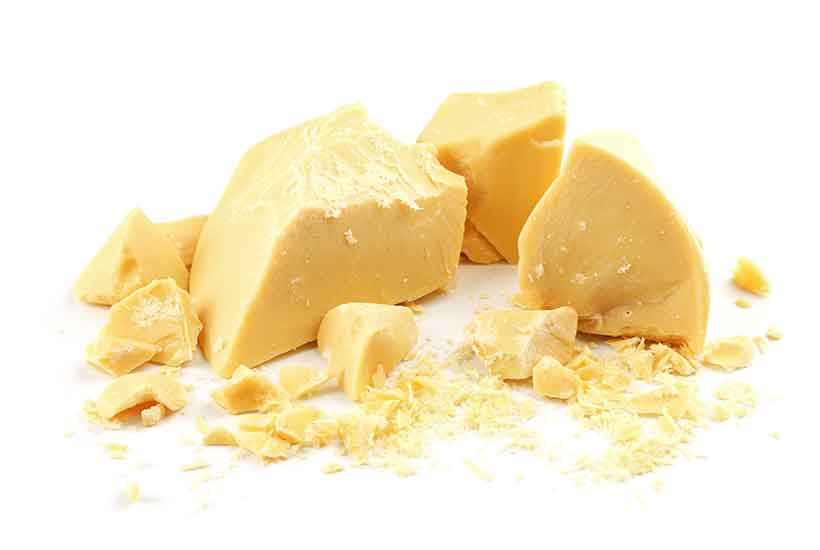
1. A Source of Healthy Fats
Fat intake is vital to our overall health and plays a role in hormonal and energy processes in the body (15).
As seen in cocoa butter’s fatty acid profile, the predominant fats are also associated with a better cholesterol profile (higher HDL to LDL) and reduced inflammatory markers.
Although cocoa butter is very high in energy/calories, the fat profile it contains is quite healthy.
2. Cocoa Butter is Very Heat Stable
Some fats, such as highly polyunsaturated vegetable oils, can break down into toxic compounds when exposed to high heat for extended periods of time (16).
However, the fatty acids in cocoa butter have good oxidative stability at high heat.
The monounsaturated fat oleic acid has shown on numerous occasions that it stands up to being heated well.
Additionally, the other prevalent fatty acids in cocoa butter are the saturated fats stearic and palmitic acid.
Saturated fats are among the most heat-stable choices for cooking due to their relative stability at heat (17).
For these reasons, cocoa butter can be used safely in a range of recipes.
3. Cocoa Butter Contains Polyphenols
You may have heard that polyphenols have an “antioxidant” effect, but this is not entirely accurate.
These compounds are, however, believed to help with cell signaling systems and play a role in mediating inflammation. In truth, more research is necessary because we do not fully understand how polyphenols exert their apparent health benefits (18).
Besides their potential benefits for us, polyphenols also help to protect cooking fats from oxidization when exposed to oxygen/heat.
This fact is one reason why polyphenol-rich extra virgin olive oil is often viewed as being one of the healthier cooking oil choices.
Similar to regular cocoa, cocoa butter also contains polyphenols, particularly flavonoids.
These compounds may add to the oxidative stability and – possibly – health benefits of cocoa butter (19).
Where To Buy Cocoa Butter?
Cocoa butter isn’t the most common ingredient you will find in stores, but it may be possible to pick it up in a local health store or market.
You can also find a wide range of options online.
Final Thoughts
Cocoa butter is a pure and natural fat that comes from cocoa beans.
In addition to its taste properties, it has a fat profile that is generally neutral for cardiovascular health, dependent on the comparator.
That said, it is worth remembering that cocoa butter is very calorie-dense and is a poor source of essential vitamins and minerals.
However, providing it is consumed in moderation, cocoa butter can fit into a healthy diet.

